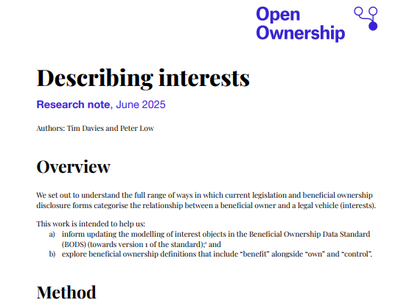What makes a beneficial owner? Exploring global differences

Photo by Nick Fewings on Unsplash.
In recently published research by Altinbas University and the Tax Justice Network, the authors argue that the design of international legal norms on beneficial ownership registration is “defective”, meaning that there is significant divergence between countries’ requirements and “poor alignment” on addressing the underlying issue of the misuse of legal vehicles.
This lack of alignment manifests in many areas of beneficial ownership disclosure, from the types of institutions charged with collecting information, to the definitions of beneficial ownership which countries use, through to the conditions which trigger a requirement for information about an individual to be disclosed to authorities. Such obstacles mean that the degree to which the data is readily usable and combinable with other sources, and integratable into different systems and processes (sometimes referred to as interoperability), is more challenging.
One approach to making information easier to combine is to organise and structure multiple sources in the same way. Open Ownership has explored this as part of its development of the Beneficial Ownership Data Standard (BODS). However, as more registers become live, the ways in which beneficial ownership is defined and how the data is gathered and structured become more varied. These developments would need to be reflected in the evolution of a data standard. To be able to understand how information from different jurisdictions can be best combined, it is necessary – but insufficient on its own – to understand the different types of beneficial ownership interests individuals can hold in legal vehicles in different contexts.
What we did
Our research involved reviewing the beneficial ownership disclosure legislation, rules, and forms from ten jurisdictions: the British Virgin Islands (BVI), Canada, Colombia, Ghana, the Philippines, Portugal, South Africa, the United Kingdom, and Zambia. These were selected on the basis that they would provide representation from different regions, and because they were countries between which we anticipated the greatest divergence in terms of their beneficial ownership transparency frameworks. This, we hoped, would quickly allow us to gain a rough indication of the breadth of diversity in how beneficial ownership interests are defined worldwide.
We supplemented the country-level review with an examination of how beneficial ownership interests are defined in key international standards and legislation: the European Union (EU) Anti-Money Laundering Regulations, the Financial Action Task Force (FATF) Recommendations, and the Organisation for Economic Co-operation and Development’s Common Reporting Standard. For each jurisdiction or standard, we recorded a list of all the distinct forms of interests described in the original terminology in the legislation, standard, and disclosure forms.
What we found
We hypothesised that as we advanced through the review, the number of new interest types which we would discover in each jurisdiction would gradually decline. However, we continued to identify new interest types in every country in this review. This suggests that there are, in fact, significant differences between how jurisdictions define beneficial ownership interests.
Common to most beneficial ownership disclosure frameworks were interest types related to:
- ownership of shares;
- voting rights;
- some aspect of control.
However, all countries in our small sample had at least one interest type that we did not find in the legislation of the others. For example:
- BVI’s legislation requires a “creditor who appoints the receiver” of an insolvent firm to be disclosed as a beneficial owner;
- Canada has the category “an individual to whom [undetermined] prescribed circumstances apply”;
- Colombia, meanwhile, has a “conditional beneficiary” category which applies to both legal entities and arrangements; and
- Ghana’s provisions require individuals with rights to change the company’s business plan to be disclosed.
Perhaps unsurprisingly, given the variety of trusts and other legal arrangements across the world, the number of different interest types for these legal vehicles was even higher than for those pertaining to legal entities.
The challenge for combining information sources
For those designing beneficial ownership transparency legislation, it is necessary to tailor the definition of disclosable interests to national laws and risk assessments in order to minimise loopholes.
For this reason, the FATF guidelines on the beneficial ownership of legal persons actively encourage the localisation of beneficial ownership definitions, and recommend that countries “consider various types of ownership interests and ways to exercise control over a legal person that exists within their jurisdiction, pursuant to commercial and administrative law”. To assist with this effort, the FATF identifies more than 24 types of interests for legislators and regulators to consider.
The downside of this localisation, when we look at information from beneficial ownership declarations from different countries, is that it increases the challenge of combining and using data from different systems. Given the high degree of divergence in how beneficial ownership interests are defined, any effort to incorporate and maintain all possible interest types, with all their individual nuances, into a unified data standard like BODS would quickly become excessively time and resource intensive. Moreover, doing so would not necessarily promote cross-jurisdictional interoperability as, for example, there might be as many distinct codelist entries for shareholding as there are jurisdictions covered by the codelist.
In some use cases, such as investigations, other features such as incorporating common identifiers into beneficial ownership registers – allowing an individual person or company to easily be identified across multiple datasets – may be more important. However, more interoperable information across jurisdictions would yield additional benefits for other scenarios. Imagine, for example, that a registrar in Latvia seeks to verify the beneficial ownership declaration of a local company that is indirectly owned by the beneficial owner through a company in Germany. If interest types were standardised, and the systems were interoperable across the two countries, the Latvian registrar could either pre-fill the form, reducing compliance burdens, or cross-check the information submitted with the information held in Germany, improving accuracy. This specific case was highlighted by legal specialists from Latvia’s BO register.
Granularity versus interoperability and user needs
A voluntary data standard, however well crafted, cannot by itself overcome the issues arising from the poor alignment of international beneficial ownership frameworks and requirements.
A standard can reasonably undertake the more modest goal of allowing users to distinguish between broad classes of interest, inviting data providers to map different interest types which may exist between an individual and a legal vehicle to a smaller number of higher-level categories, such as ownership, control, or benefit (the latter is sometimes included within the scope of ownership interests, as in, for example, the EU Anti-Money Laundering Regulation).
This would inevitably mean that structured data would not standardise some of the finer details of the context-specific ways in which beneficial ownership is held. However, by providing an additional space to disclose context-specific interest types, a standard can make sure users have access to the detail required to take actionable decisions about individual disclosures. It may be then that in a fully interoperable global system, cross-jurisdictional interfaces would only be able to show that Person X has control over an entity in a particular country, rather than sub-dividing all the possible kinds of ways that Person X exercises their control, such as by their power to change the company business plan.
Based on our research with data users, the loss of granularity of detail could be detrimental for some use cases, for example, for tax authorities wishing to determine the resultant tax liability of the specific relationship between an individual and an asset. However, for many other use cases, it may be that it is the existence of the interest – and perhaps whether it is one of ownership, control, or benefit – that is the most valuable aspect to capture in an interoperable system. Only users can answer these questions, and further research is needed to better understand trade-offs between granularity and interoperability from a user perspective.
What’s next?
The task of determining and prescribing the minimum components of a globally interoperable system of beneficial ownership frameworks is better suited to multilateral bodies with the capacity to nudge a sufficiently large number of jurisdictions to adopt any eventual common global standard. While no multilateral body has taken on this task yet, multiple efforts are being made to improve information-sharing between agencies and countries. Standardisation may emerge as these efforts accelerate, offering significant gains for users and handlers of beneficial ownership data.
Peter Low is an international development consultant. He was previously Open Ownership’s Head of Implementation Strategy until October 2023.
Publication type
Emerging thinking
Blog post
